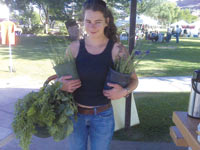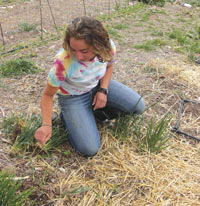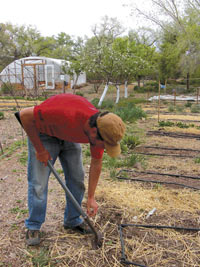Sustainable Happenings May 2011
A Growing Revolution
photographs and story by Joan Gough

Have you ever tried to talk about farming without using metaphors of sowing, planting, harvesting? In interviewing Jen Sadoff director of the Youth Garden Project this came up, and as she said, “They just sprout up naturally.” Our languagereflects the essential nature of farming in our lives, even if we have little direct experience digging in the dirt.
In February, I wrote about planning your garden. If you haven’t done it already, it isn’t too late. But, if you can’t or just don’t want to garden for whatever reason, you are not locked out of fresh, locally grown foods. You can always frequent the Farmer’s Market, community supported agriculture, grocery stores, and even restaurants--all of which buy vegetables, dairy, and meat from local and regional farmers--farmers with last names like White and Helfenbein rather than “Corporation.”
 The first farmer’s market I remember in Moab was on the still vacant lot next to Sew Moab. Will Petty donated the use of the lot and hired Candace Butterworth to manage the market and his operation called Shojun Farms. After two years, management of the market was taken on by other farmers--Sarah Heffron and David Svendson, Christopher Kauffman and Adrea Lund. In 2002, the market was moved to Swanny City Park under the management of the Youth Garden Project and, then director, Cari Militano. Today, there are farmers, food vendors, artists and various non-profit groups with booths at the park, either selling their products or giving away information.
The first farmer’s market I remember in Moab was on the still vacant lot next to Sew Moab. Will Petty donated the use of the lot and hired Candace Butterworth to manage the market and his operation called Shojun Farms. After two years, management of the market was taken on by other farmers--Sarah Heffron and David Svendson, Christopher Kauffman and Adrea Lund. In 2002, the market was moved to Swanny City Park under the management of the Youth Garden Project and, then director, Cari Militano. Today, there are farmers, food vendors, artists and various non-profit groups with booths at the park, either selling their products or giving away information.

The market has grown and diversified, but you will still find the staple of a farmer’s market--fresh produce. The market will open Saturday, May 7 this year and run through the end of October. Vendors, tourists and a good part of the community show up every Saturday morning from 8 a.m. to 12 noon to shop and visit. Jen Sadoff is anticipating produce from the Youth Garden, Larry White of Creekside Organics, Charles Christensen, and Walker Farms to name a few. Goat cheese maker Eric Secrist and his partners of Castle Valley Creamery will be there again with their popular feta, chevre, and yogurt. Regional bakers from Panaderia La Cocina and High Desert Foods will be back with bread and other baked goods. When orchards are producing, you can look forward to apricots, plums, peaches, apples from the Grand and Moab Valleys. With Moabite’s renewed interest in beekeeping, look for local honey--every bottle with a unique hue and flavor. Fresh eggs with rich color, flavor and a broad spectrum of nutrients will also be available.
 Another way to eat well is through a community supported agriculture (CSA) program. You pay farmers at the beginning of the season a set amount, giving them capital to buy seeds, fertilizer, new irrigation pipe, etc. Then the farmer providess produce to you once a week. From people I’ve talked to, the advantages are produce of great and interesting variety just hours from the soil. With many CSA’s you can exchange part of the cost for labor.
Another way to eat well is through a community supported agriculture (CSA) program. You pay farmers at the beginning of the season a set amount, giving them capital to buy seeds, fertilizer, new irrigation pipe, etc. Then the farmer providess produce to you once a week. From people I’ve talked to, the advantages are produce of great and interesting variety just hours from the soil. With many CSA’s you can exchange part of the cost for labor.
If you miss the Farmers’ Market and a CSA isn’t right for you, you still aren’t completely out of luck. Moonflower and Village Market carry local produce and Castle Valley Creamery cheeses and yogurt. They both also carry Epicurean Honey from Parachute, Colorado. Moonflower carries garlic from Brown’s Hole, grass-fed beef raised by local rancher Ken Helfenbein, beans from Adobe Milling in Dove Creek, and pesto from the Youth Garden. According Cassie Paup, assistant-manager of Moonflower, they have a “stringent ingredient policy” for such items as the pesto which includes the use of local produce grown without pesticides. Nancy Willis, produce manager at Village Market, says they will again have asparagus, herbs, tomatoes, potatoes, cucumbers and apples from Castle Valley growers Wendy and Jerry Harris.
If you are looking for locally and regionally raised meat, another source is Ye’ol Geezer Meat Shop owned by Rich and Pat Evans. According to Pat, the beef must be grass fed and then finished on grain for 60 to 90 days. Lamb and pork are raised for them by Lamar Walker in Monticello. Rich and Pat have the meat slaughtered and then after aging, they butcher it. They cure their own bacon and hams and Pat makes a wide variety of sausage. Besides meat, you can pick up local duck and chicken eggs, garlic and other produce in season.
Finally, in Moab you can even eat at a restaurant and get some locally produced food. Penelope Decaria of Love Muffin says she uses as much local produce as possible, but since it is sometimes difficult to get consistently, she uses it in specials which they advertise in-house. She said it has been enthusiastically received. Some of the other restauranteurs who buy locally and/or raise their own produce and meat are the owners of Paradise Pizza, Buck’s Bar and Grill, EklecticCafe, Jeffery’s Steak House, Peace Tree, and the Mandarin Szechuan.
If you want a great read on becoming a locavore, as in local, not loco, pick up Barbara Kingslover’s Animal, Vegetable, Miracle. It is funny and inspiring and includes practical ideas and recipes. Speaking of recipes, Deborah Madison’s cookbook Local Flavors was specifically inspired by farmer’s markets. And another great cookbook for eating elegantly and locally is Alice Water’s The Art of Simple Food.
Whether you garden or buy from local farmers, may you reap the health and flavor rewards of good food.